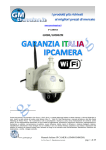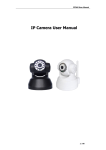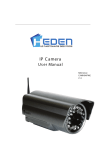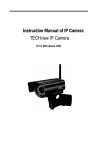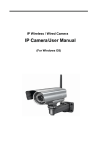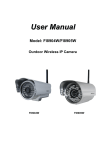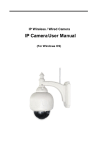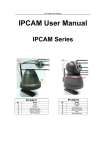Download IP Camera User Manual
Transcript
IPCAM User Manual IP Camera User Manual 1 / 61 IPCAM User Manual Content 1. User Manual brief introduction…………………………………………………………..4 1.1 Appointment…………………………………………………………………………..4 1.2 Cautions………………………………………………………………………………..4 1.2.1 Installation environment………………………………………………………4 1.2.2 Transporting and carrying…………………………………………………….5 1.2.3 Maintenance and protection…………………………………………………..5 1.2.4 Packing list.……………………………………………………………………..5 2. Products overview…………………………………………………………………………..6 2.1.1 Features………………………………………………………………………………6 2.1.2 Advanced Features…………………………………………………………………..7 2.2 Product views…………………………………………………………………………..8 2.2.1 Front views………………………………………………………………………8 2.2.2 Interface…………………………………………………………………………9 2.3 PC System Requirements.……………………………………………………………..9 2.4 Hardware Instruction…………………………………………………………………9 2.5 Software installation………………………………………………………………….10 3. SOFTWARE OPERATION……………………………………………………………….12 3.1 IP Camera Tool……………………………………………………………………….12 3.2 Camera Login………………………………………………………………………...15 3.3 For Visitor.…………………………………………………………………………….21 3.4 For operator…..……………………………………………………………………….22 3.5 For Administrator.……………………………………………………………………22 3.5.1 Multi-Device Settings.…………………………………………………………23 3.5.2 Network Settings………………………………………………………………25 3.5.3 UPnP and MSN settings………………………………………………………27 3.5.4 DDNS Service Settings ………………………………………………………..30 3.5.5 Mail and FTP Service…………………………………………………………31 3.5.6 Motion Detection………………………………………………………………36 4. HOW TO USE……………………………………….. ……………………………………38 4.1 Step by step to use……………………………………………………………………38 4.2 Setting Wi-Fi of IP Camera …………………………………………………………39 4.3 Using a router to access the Internet ……………………………………………….39 4.4 Static IP user…………………………………………………………………………41 4.5 How to use DDNS……………………………………………………………………42 5. APPENDIX…………………………………………………………………………………45 5.1 Frequently Asked Questions……………………………………………………….. 45 2 / 61 IPCAM User Manual 5.1.1 I have forgotten the administrator username and/or password. ……………………45 5.1.2 IP Address configuration………………………………………………………………45 5.1.3 Network Configuration…………………………………………………………………46 5.1.4 No pictures Problems with ActiveX Controller……………………………………….46 5.1.5 Problems with network bandwidth……………………………………………………47 5.1.6 For example: Register procedure from a DDNS web…………………………..……47 5.1.7 Why pop-up the prompt ”Fail to connect to the device…”? ………………….53 5.1.8 Can’t access the IPCAM in the internet? ………………………………………………. 54 ……… 5.2 Operate common problem solving……………………………………………… ……… 54 5.3 IPCAM special use………………………………………………………………………………..56 5.31 Use vlc player and mplayer to play ip camera audio data prompt. …………....………56 5.32 Set the camera miscellaneous parameters…………………;…………………………….59 5.4 Default Parameters……………………………………………………………………………….59 5.5 Specification………………………………………………………………………………………59 3 / 61 IPCAM User Manual 1.User Manual brief introduction Thank you for choosing our network ip camera. The manual can help you to use the camera correctly. Some descriptions maybe aren’t perfect. If you meet unsolvable problems according to this manual,please contact the product supplier.The camera’s software,hardware and shell will update ,we will be subject to change without notice.But we will released updated notice on our website,please pay attention to it. 1.1 Appointment Please obey this manual strictly to use the camera. 1.2 Cautions Before using the camera, please read all the safety instructions as below carefully then install . 1.2.1Installation environment The camera can be installed indoor ,if outdoor, please add waterproof components and lightning protection equipment; Working temperature limited to 0 ℃ ~ 50 ℃ between, humidity limited to 5% ~ 90% (non-condensable) Banned in inflammable, explosive environment install and use; Avoid installing in strenuous vibration place, do not put other equipment on the camera; Avoid installing near a strong field of electronic equipment that could cause the unit cannot be normal use and even damage; To ensure the normal radiating of camera, should avoid the poor ventilation places or high temperature environment; Use wireless ip cameras, should try to avoid or reduce transmission range of obstacles 1.22 Transporting and carrying The camera package has aseismatic design and testing, ensure ip cameras will not be accidental breaking during transport, in handling this unit, it is best to use original package. Avoid moving the camera between extreme cold and hot place, Avoid machine internal dewing, affect the service life of equipment. 4 / 61 IPCAM User Manual 1.23 Maintenance and protection Non-professional maintenance personnel, do not tear open the camera, avoid damage and shock Please use the original configuration of the power adapter, use unauthorized power adapter can damage of the camera. Please do not touch canera’s lens, it will leave fingerprint on it that cause image blurring; Do not put liquid in the unit, lest cause machines internal short circuit or fire. The camera software upgrade process cannot without electricity, otherwise it will damage it, the software prior to upgrade, It is best to restart camera, and ensure the external no other users are visiting. 1.24 Packing list Item Quantity IP Camera 1 piece Wi-Fi Antenna 1 piece CD 1 piece(Include User Manual、IP camera tool) DC Power Supply(5V 2A) 1 piece Network Cable 1 piece Mounting bracket 1 piece (option) (only wireless IPCAM user) Optional : One Wire for alarm input/output NOTE: Contact us immediately in the case of any damaged or short of contents. 5 / 61 IPCAM User Manual 2 Products overview IPCAM is an integrated wireless IP Camera solution. It combines a high quality digital video Camera with network connectivity and a powerful web server to bring clear to your desktop from anywhere on your local network or over the Internet. The basic function of IPCAM is transmitting remote video on the IP network. The high quality video image can be transmitted with 30fps speed on the LAN/WAN by using MJPEG hardware compression technology. The IPCAM is based on the TCP/IP standard. There is a WEB server inside which could support Internet Explore. Therefore the management and maintenance of your device become more simply by using network to achieve the remote configuration, start-up and upgrade firmware. You can use this IPCAM to monitor some special places such as your home and your office. Also controlling the IPCAM and managing image are simple by clicking the website through the network. NOTE: You can use the IP Camera Step by Step(details: 3). Some functions depend on Model. 2.1.1 Features ● Powerful high-speed video protocol processor ● High-sensitivity 1/4" CMOS sensor ● 300K Pixels ● IR night vision(Range:3~5m) ● Optimized MJPEG video compression for transmission ● Multi-level users management and passwords definition ● Embeded Web Server for users to visit by IE ● Support wireless network (Wi-Fi/802.11/b/g)mobile ● Supporting Dynamic IP (DDNS)and UPnP LAN ● Giving alarm in cause of motion detection ● Support one-way (I/O) alarm connection ● Supporting image snapshot ● Support multiple network protocols: HTTP/TCP/IP/UDP/STMP/DDNS/SNTP/DHCP/FTP ● Support remote system update 6 / 61 IPCAM User Manual 2.1.2 Advanced Features Multi-Protocol support and Transportation IPCAM supports Multi-Protocol such as TCP/IP, SMTP and HTTP. Sending the image to your mailbox automatically when the IPCAM is triggered. Motion Detection Your may use the internal Motion Detection function or external sensor to trigger images recording and transportation. Alarm sensor input/output The detection sensor sends an alarm and records it by itself when there is a fire or accident. A message as an email is send to you by this sensor. (The input/output discreteness can be chosen) DDNS support Using the IPCAM in the condition which including ADSL and IP change often is more convenient, because IPCAM provides dynamic DNS function. Advanced User Management Only allowing authorized users access to real-time images of the IP Camera. 7 / 61 IPCAM User Manual 2.2 Product views 2.2.1 Front views WIFI antenna Metal & waterproof design Sensitive Hole 5P Lens Infrared LED Figure 1.1 1 SensitiveHole 2 Infrared LED 3 Network Indicator LED If there is network activity, the LED will blink. 4 LENS CMOS sensor.You can turn around the lens manually to adjust the focus range. 5 Built-in Mic 2.2.2 Front views WIFI antenna RJ_ 45 Part Reset but ton DC 5V Figure 1.2 8 / 61 IPCAM User Manual LAN : RJ-45/10-100 Base T DC5V : 5V/2A Power supply RESET BUTTON: Press and hold down the RESET BUTTON for 5 seconds.Release the power button and IP camera will be reset back to the factory default parameter Figure 1.3 2.3 PC System Requirements System configuration requirements: ( Example for view four IP Camera ) CPU: 2.06GHZ or above Memory: 256M or above Network Card: 10M or above Display Card: 64M or above memory Recommendable Operating System: Windows2000 ,Windows XP,VISTA,WIN7 Support web browser: IE. FireFox. Google etc . 2.4 Hardware Instruction Fol ow the steps below to set up your camera hardware. Make sure to follow each step carefully to ensure that the camera operates properly. 1) Plug the network cable into the camera and then into your Cable/DSL router. 2) Plug the power adapter into the camera and then into the power outlet. IP Camera E IP Camera D Figure 1.4 9 / 61 IPCAM User Manual CAUTION: Make sure to only use the power adapter supplied with IPCAM. Using a non-approved power adapter may damage the camera. 3) The camera takes approximately 30 seconds to start up before it displays an IP address on the IP Camera Tool(details: 3.1). 4) When the camera is powered and network cable plug correctly.It s head wil turn around and the Network Indicator LED is blank. 2.5 Software installation Software installation is the key to the successful use of this product. 1 Open the CD,find the software as instruction; Figure 1.5 2 Click IPCamSetup.exe and install the software as instruction Figure 1.6 10 / 61 IPCAM User Manual 3 .Click Next Figure 1.7 4.Click Next Figure 1.8 5.Choose restart then click Close The computer restarts upon installation completion and an icon appears on the desktop automatically. NOTE: Before installing and using the product, please read the following precautions carefully and make sure they are fully understood. Use only the power adapter attached with the product. Use of unauthorized power adapter may cause damage to your IP Camera. IP Camera terminal shall be installed in an indoor environment. 11 / 61 IPCAM User Manual 3 SOFTWARE OPERATION 3.1IP Camera Tool When the Device has been mounted properly, you can double click the icon “IP Camera Tool” and a dialog box as Figure 1.9 wil pop up. Figure 1.9 Note: The software searches IP Servers automatically over LAN. There are 3 cases: 1 No IP Camera found within LAN. After about 1 minute search, the Result Field will show “not found IP Server” and the program shut automatically; 2 IP Cameras having been installed within LAN. Al the IP Cameras will be listed and the total number is displayed in the result field as shown in Figure 2.0. 3 The IP Cameras installed within LAN do not share the same subnet with the monitoring PC. A prompt as shown in result field (prompt: Subnet doesn t match,dbclick to change!). Click the left mouse button to choose the prompt and click the right mouse, choose Network Configuration to set the IP address of the Camera to the same subnet as LAN. Five Options Choose the IP Camera list and Click right mouse button,there are five options,Basic Properties, Network Configuration, Upgrade Firmware, Refresh Camera List, Flush Arp Buffer as shown Figure 2.0. 12 / 61 IPCAM User Manual Figure 2.0 Basic Properties There are some device information in the Basic Properties, such as Device ID, System Firmware Version, Web UI Version Figure 2.1 Network Configuration In this page, you can configure the Network parameter. Figure 2.2 13 / 61 IPCAM User Manual IP address: Fill in the IP address assigned and make sure it is in the same subnet as the gateway.(i.e.the first three sections are the same) Mask: The default subnet mask of the equipment is: 255.255.255.0 Gateway: Make sure it is in the same subnet with PC IP address. Default Gateway address is 192.168.1.1 DNS: IP address of IPS network provider. Figure 2.3 14 / 61 IPCAM User Manual Port: LAN port assigned for the equipment, usually 80 User & Password : Default administrator username/password: admin/No password Enable Using DHCP the system wil assign a reasonable IP address for your equipment only if your gateway supports DHCP (It is the case with most gateways). DHCP checkbox: if checked, the device wil obtain IP from DHCP server (To be make sure the Router which the device connect with has DHCP function). NOTE: when the prompt ”subnet doesn t match, double click to change!”, please set the IP Camera IP address once again. l Upgrade Firmware Enter the correct User and Password to upgrade system Firmware and Web UI. Figure 2.4 l Refresh Camera List Refresh camera list manually. l Flush Arp Buffer When cable network and wireless network of the device both are fixed IP address. There is a problem you may encounter is can search the camera IP but can t open the camera web page.you may try to use flush arp buffer. 3.2 Camera Login You can access the camera : 1.through IP Camera Tool or IE directly. Double click the IP address of the IP Camera listed(Figure 2.0).IE wil be opened 15 / 61 IPCAM User Manual automatically and display the camera login page. 2. Access the camera by IE browser directly, type in the camera s IP address. for example. 1)By IE browser as below: Figure 2.5 The Camera Login page pop-up. Figure 2.6 16 / 61 IPCAM User Manual enter your account and password on the login page as shown in Figure 2.6. By default, administrator s username is: admin and no password. Figure 2.7 Click “Sign in” to enter the monitoring page(Figure 2.8).You can set the username and password as Administrator, Operator or Visitor. Figure 2.8 17 / 61 IPCAM User Manual 2) By Mozilla Firefox browser as below: Figure 2.9 The Camera Login page pop-up. Figure 3.0 18 / 61 IPCAM User Manual Click sign in,Server Push Mode’s functions are less than ActiveX Figure 3.1 4. with mobile phones equipped with special tools wap browser visit IPCAM with computer access similar as follows: Popup equipment connect interface: Figure3.2 19 / 61 IPCAM User Manual Click Sign in Figure 3.3 Also can browse ip camera by inputting ip address to browser: Figure 3.4 20 / 61 IPCAM User Manual 3.3 For Visitor For example: if is bright ,the first route is on Detection(Motion Detection). Figure 3.5 If you want to detect 4 views , need to click this ico .The first you should add more deivce.see details in 3.5.1 Multi-Device Settings. OSD: Display date and time on the video. You can disable the OSD function or choice other color. (OSD:on-screen display) Snapshot: Click ico REC: Click ico Audio:Click ico to snap the picture. into REC mode, into Audio mode, Talk:Click ico into Talk mode, range. is stop. can listen the voice in monitoring range.. Visitor can talk with whom is in the monitoring Note: the record file name is: device Alias_ Current time.Avi For example: IPCAM_20101211134442.Avi It means the device alias is IPCAM and its record s end time is : At 13:44:42 on December 11, 2010.When use motion detection and checked Send Mail on Alarm. The name of the picture received in mailbox is like this: device id(Alias)_ Current time.jpg For example: 00606E576A02(IPCAM)_m20101216212745.jpg It means the device ID is 00606E576A02, the device alias is IPCAM and its picture s time 21 / 61 IPCAM User Manual is : At 21:27:45 on December 16, 2010 3.4 For operator When login as operator or administrator,you can enter the For Operator Figure 3.6 Direction control: click the different arrow wil get different direction view. Image around flip Image fluctuation flip Resolution: VGA(640 X 480)/ QVGA(320 X 240) Mode: 50Hz/60Hz/Outdoor • color parameter:Click or can adjust brightness and contrast . 3.5 For Administrator When you login as administrator, “For Administrator” is enabled. Device Info:You can find the information about Device ID,Firmware Version and Embeded Web UI Version. 22 / 61 IPCAM User Manual Figure3.7 Alias Settings: You can Input the new name as you like. Data &Time Settings: Data &Time Settings page. Users Settings: Eight accounts are acceptable for this system. Here the eight users can configure their user names and password as Administrator, Operator or Visitor. l Visitor: In this mode, you can only view. l Operator: You can control the direction of IP Camera and set some parameter. l Administrator: You can setup the advanced configurations of the IP Camera. UpnP Settings: If you access IP Camera, to be make sure UpnP Status is Succeed. Upgrade Device Firmware: Upgrade Device Firmware and device embeded web UI software in this page. Restore Factory Settings: Restore factory settings of the device. Reboot Device: Reboot the device. Back: Back to Monitoring Mode. 3.5.1 Multi-Device Settings l Add cameras in LAN In the Multi-Device Settings page, you can see all devices searched in LAN. The 1st Device is this device in default. You can add more cameras list in LAN for monitoring. This Web software supports up to 4 IP Cameras online simultaneously. Click “The 2ND Device” and Double click the item in the “Device List in LAN”, Alias、Host and Http Port will fil in automatically. Enter the correct username and password then click “add”.Add more cameras in the same way. 23 / 61 IPCAM User Manual Figure3.8 l Add cameras in the Internet Firstly, make sure the camera added can access in the Internet with the IP address or DDNS domain. or http://IPCAM.dyndns.org:9008 You can enter the Host: 219.133.200.165 port: 81 or Host: IPCAM.dyndns.org port: 81.Enter the correct username and password then click “add”. Add more cameras in the same way as shown in Figure3.20 Figure3.9 24 / 61 IPCAM User Manual Figure4.0 3.5.2 Network Settings l Basic Network Settings If the router that the IP camera connect has DHCP function, you can choice “Obain IP from DHCP Server”else fil in the network parameters manually. Http Port: In most cases, you can leave this value as 80, however, if your Internet Service Provider blocks this port, you may switch to another port number such as 8999. Figure4.1 25 / 61 IPCAM User Manual l Wireless LAN Settings 1) Please enter the wireless net setting page of the wireless Router to find out SSID, Channel(less than 10), Encryption Authentication as below: Figure 4.2 figure4.3 2) As Administrator to Login camera, open wireless LAN Settings page, fill in every setting(ensure keep the same as router s ), and then pulled out of the cable, wireless network function can be used. For example: as shown in figure4.4 26 / 61 IPCAM User Manu Figure4.4 3.5.3 UpnP and MSN settings 1) UpnP setting: If you wanna browse by Internet,you have to use UpnP to Map Port,check this function then click Submit button. Figure 4.5 27 / 61 IPCAM User Manual 2) MSN Settings Fill in your MSN account and password, then add account which need to receive IPCAM S ip address to IPCAM S MSN list (Figure 4.6),click submit then you d better restart IP camera. After it ,login your MSN to add IPCAM s MSN account to MSN List that you can receive IPCAM s ip address. Figure 4.6 First login and click "add contacts " choose Add Contact ,then fill IPCAM s MSN account in "instant messaging address" ,click next then send offers. Figure4.7 28 / 61 IPCAM User Manual Next: Figure4.8 . Figure4.9 When IPCAM s MSN account shows online you can chat with it, input path command "url?" camera account will show its IP address in chatting box promptly as below : Figure5.0 29 / 61 IPCAM User Manual You can input the IP address to browser then can browse ip camera as below: Figure 5.1 Attention:You should fill MSN account in IPCAM first. 3.5.4 DDNS Service Settings DDNS Service: The system supports protocols from some DDNS providers: Dyndns.org. User and Password: the user name and password used when applying for the domain name. (details:4.5) DDNS Host: the Domain Name DDNS or Proxy Server: If you access the DDNS host through a proxy, you should input the Proxy IP. DDNS or Proxy Port: Proxy Port Figure 5.2 30 / 61 IPCAM User Manual 3.5.5 Mail and FTP Service Note: When Alarm Service Settings-> Send Mail on Alarm is check, the Mail Service takes effect. Figure 5.3 Configure the E-mail box to receive and send mails. The E-mail box is used for receiving the images sent after alarm and the system IP address after successful dial-up. Sender: This device use the sender mailbox to send mails. Receiver: To receive the mail from the Sender. You can set up to 4 receiver mailbox. SMTP Server: the SMTP server for the sender mailbox Need Authentication: if the sender mailbox need authentication, you should check it then input the SMTP username & Password. Mail test: Please set the Mail parameter and click "Submit" first. There are Mail test result. Figure 5.4 31 / 61 IPCAM User Manual Gmail also set as the same Figure5.5 1 Can not connect to the server 2 Network Error. Please try later 3 Server Error 4 Incorrect user or password 5 The sender is denied by the server. Maybe the server need to authenticate the user, please check it and try again。 6 The receiver is denied by the server. Maybe because of the anti-spam privacy of the server 7 The message is denied by the server. Maybe because of the anti-spam privacy of the server 8 The server does not support the authentication mode used by the device Report Internet IP by Mail: When ipcam port or Internet IP changed, it will send the internet IP by mail. Make surethe port is map to the router correctly by UPNP or Virtual Map function. 2)FTP Server use and settings If you already have an FTP Server (ipcam. com)and email ipcam ,you can fill the parameters as below: IPCAM User Manual Figure 5.6 FTP Server of LAN as below: 1. Creat an account Figure 5.7 2. Step by step setting until finish it. 33 / 61 IPCAM User Manual Figure5.8 3. Start Server Continue to finish it Figure 5.9 34 / 61 IPCAM User Manual 4. IPCAM S account can be used. Figure 6.0 5. IP camera s FTP Server set Figure 6.1 6. Set up and complete testing is successful,when it alarms, IP camera will upload pictures to the FTP server Settings of main directory path (as shown ) 35 / 61 IPCAM User Manual Figure6.2 FTP Server: the FTP server address. FTP port: the port usually is 21 FTP Mode: support standard(POST) mode and passive(PASV) mode. Upload Image Now: it wil upload image now when checkbox is not checked. When checked, you can input upload interval(Seconds) 3.5.6 Motion Detection Enter Alarm Service Settings page to configure Motion Detection function. Motion Detect Armed When you enable motion detect armed, the camera can be triggered to send email alerts and record images. In the camera monitoring page, the green icon turn to red and an alert sound you wil hear, Motion Detect Sensibility Input Pins: The input pins can be used for 1-way external sensor input. For example, you may connect a Person Infrared Sensor (PIR) to it for motion detection. When external sensor triggered, IPCAM can be programmed to send an email with picture or 36 / 61 IPCAM User Manual control the internal relay output. If you link a external alarm with Pin3 and Pin4,when enable alarm input armed, external alarm is enabled. Send Mail on Alarm Sent picture and mail inform to customer s e-mail after alarmed.(firstly you should finish the Mail Service Settings.) Choose it. Figure6.3 Upload Image on Alarm Enable upload image on alarm and set upload interval(Seconds). When alarming it will upload pictures to choosing email and FTP server after setting Figure6.4 REC automatically and save to PC When you enable motion detect and open the camera monitoring page on the PC. If 37 / 61 IPCAM User Manual there is an alarm triggered, REC wil start automatically for several seconds and save to the PC. Figure6.5 REC save to pc s position Figure6.6 4 HOW TO USE 4.1 Step by step to use Fol ow the instructions below to get started after the Camera has been mounted properly.When the IP camera powered on, it wil rotate itself and stop to the center. 1) Use Network cable connect IP Camera to LAN. 2) Enter IP Camera Tool to set the basic configuration.(details: 3.1) 3) When IP address of the Camera listed in the Result Field of the IP Camera Tool, it means the basic configuration is completed. 4) set the safety property of IE in the PC when you view it first time.(details: 5.1.3 ) 5) Camera login(details:3.2) 6) Now you can use the IP Camera as Visitor, Operator or Administration in the LAN. 38 / 61 IPCAM User Manual 4.2 Setting Wi-Fi of IP Camera 1) To use the wireless functions of the IP Camera,a wireless router like linksys is required. 2) Enter the wireless router setup page(you may see the wireless router user manual).To Find out the SSID, Channel(less than 10), Security Way(NONE,WEP),Authentication Type,encryption. 3) Enter Wireless LAN Settings to input contents gotten from the wireless router then click Submit to reboot the device. NOTE: This product only supports WEP encryption. Figure6.7 4) Wait at least 30 seconds to unplug the ethernet cable, then unplug the power supply. 5) Plug the power supply making sure that the ethernet is not connected 6) After around 30 seconds, if the LED blinks ,it indicates it is working in wifi mode 7) Camera login.(details:3.2) 4.3 Using a router to access the Internet Using a router to access the Internet by shared ADSL If a router is set for dial-up Internet access,it is not required to set ADSL dial-up account and password on the IP Camera. IPCAM User Manual Figure6.8 1) Use Network cable connect IP Camera to the LAN. 2) Enter IP Camera Tool to set the basic configuration.(details:3.1) 3) login the Camera homepage as Administration 4) Enter DDNS Settings Page and ennable DDNS service.Click <submit> and the device will reboot.(detail:3.5.4) Figure6.9 5)How to use DDNS service (detail:4.5) 6) You can access the Camera from Internet by domain name. 40 / 61 IPCAM User Manual 4.4 Static IP user Static IP user is not need to use DDNS for remote access. When finished the setting of the IP Camera in LAN, you can access the Camera directly from Internet by the WAN IP. You can obtain the WAN IP by two ways. Obtain the WAN IP from some Website You can discover this easily by opening on a computer using the same connection as the IP camera and entering this address: http://www.whatismyip.com.The page at this address wil show you the current WAN IP. Figure7.0 According to MSN and IP camera built-in account access (details:3.53) Obtain the WAN IP address from the router Take the WRT54G router of LINKSYS for example, 1) Obtain the IP address of the router(LAN gateway address),user name and password for logon to the router from the network administrator, 2) Enter the LAN IP address of the router(LINKSYS WRT54G default:192.168.1.1) in the address bar of the IE to log on to the router; Open the Status page to find out the WAN address of the router. 41 / 61 IPCAM User Manual Figure7.1 Access the IP Camera from the Internet User can access the IP Camera from the Internet, Enter WAN IP address + port number in the IE to access IP Camera. Note: Make sure the Port mapping is success. You can do port mapping by two ways: l Enter setting page of the router which IPCAM connect with to enable UPNP function. Enter IPCAM “UPnP Settings” to enable UPNP and make sure the state is “UPnP success”. l If your router has the Virtual Map function. Enter router setting page, add IP CAM s IP and port to the Virtual map list. 4.5 How to use DDNS When use ADSL, the IP Camera will connect to the Internet through ADSL automatically. For each ADSL reconnection, ISP wil re-assign a new IP address for the IP Camera to facilitate the access. DDNS(Dynamic Domain Name Server) can map the dynamic IP address of an IP Camera to a fixed domain name. Therefore, we can access the IP Camera by the fixed domain name whether the IP address changes or not. The IP address is not necessary when you using the DDNS via the domain name to find your network. 42 / 61 IPCAM User Manual 1) Go to the website which Provides free domain name, register and apply a free domain name. such as http://www.dyndns.com(details:5.1.6 ). 2) login the Camera homepage as Administration and enter ”DDNS Service Settings” page input the name, password and Host(details: 3.5.4) .Then click <SUBMIT> and reboot Device. 3) Re-login the Camera homepage and enter”DDNS Service Settings”page to check the DDNS Status is DynDns Succeed or not. 4) Enter”UPnP Settings”page,the UPnP Status should be UPnP Succeed.If the status is not Succeed, you may enter “Basic Network Settings” page to change Http Port (details: 3.5.2). Then click <SUBMIT> and reboot Device. 5) Re-login the Camera homepage to check and make sure the DDNS Status and UPnP Status is Succeed. Figure7.2 6) You only need to enter the domain name(domain name+Port number in the IE address bar ,the browser wil visit the IP Camera.Wait for several minutes and the IP Camera wil dial up to access the Internet automatically, and the communication with the DDNS server is established successfully. In the way, the user can access the IP Camera from a WAN by using the DDNS domain name. If the gateway settings and DDNS settings have been completed,ener the DDNS dynamic domain name. in the address bar of the IE to access the IP Camera.If multiple IP Cameras are connected to the same router,enter DDNS dynamic domain + port number(in the address bar of the IE to access different IP 43 / 61 IPCAM User Manual Cameras. You will view the pictures as below: Figure 7.3 Figure 7.4 44 / 61 IPCAM User Manual Add more devices: Figure7.5 5 APPENDIX 1.1 Frequently Asked Questions Note: 1) Any question you would meet, please check Network connections firstly. 2) Check the working status revealed by the indicators on the network server, hub, exchange and network card. If abnormal, check the network connections. 1.1.1 I have forgotten the administrator username and/or password. To reset the administrator username and password, Press and hold down the RESET BUTTON for 5 seconds. Release the power button and the username and password will be reset back to the factory default administrator username and password. Default administrator username: admin Default administrator password: No password 1.1.2 IP Address configuration Check whether IP address of the IP Camera server shares the same subnet as your work station: Click My Computer > Control Panel>Network & Dial-up Connections > LAN > Attributes >Internet Protocols (TCP/IP), and check IP Address and Subnet Mask. Make sure they are in the same subnet when configuring IP Camera IP 45 / 61 IPCAM User Manual address manually.Unable to access IP Camera via web browser 1.1.3 Network Configuration Double Check to ensure that your HTTP server software is configured and running properly. If you re running any firewall software, make sure it s allowing inbound connections to port 80,Also, if you happen to be using a cable/DSL router, make sure you ve set up port forwarding properly. ( consult your router s documentation for more information ) .If none of these seem to be the problem, it s also possible that your ISP is blocking inbound connections to port 80 –many IPSs have done this because of internet worms such as Code Red, If this is the case, you „ll have to setup your HTTP server on an alternate port (such as 8080). 5.1.4 No pictures Problems with ActiveX Controller The video streaming is transmitted by the ActiveX controller. If ActiveX control er isn t installed correctly ,you will see no video image. There are two way to solve this problem: 1) Install “IP Camera Tool”, ActiveX controller is installed simultaneity (recommendable). 2)download ActiveX controller and set the safety property of IE in the PC when you view it first time:“IE” browserà“Tool”à“Internet Proper”à“Security”à“Custom Level”à”ActiveX control and Plug-ins” three options of front should be set to be “Enable”, The ActiveX programs read by the computer wil be stored. as fol ows: Enable: Download unsigned ActiveX controls Enable: Initialize and script ActiveX controls not marked as safe Enable: Run ActiveX controls and plu-ins Figure 7.6 46 / 61 IPCAM User Manual Figure7.7 5.1.5 Problems with network bandwidth The image frame rate is subjected to the following factors: 1.network bandwidth; 2. PC performance,network environment and display preference setting (brightness, theme, etc.); 3. the number of visitors (Too many visitors wil slow down the image frame rate.); 4. choice of switch or hub (Use a switch for multiple IP Camera Servers rather than a HUB.). 5.1.6 For example: Register procedure from a DDNS web 1.Users use DDNS management system first time.Users need to apply account to manage and inquire the domain state. Step1: enter http://www.dyndns.com/ and Create Account.( Fill in Domain Name .dyndns.org then Click Add) 47 / 61 IPCAM User Manual Figure7.8 Step2: enter your information Figure7.9 48 / 61 IPCAM User Manual Figure8.0 Step3: After a minute, you wil receive an E-mail from DynDNS Support and it will give you a confirmation address (e.g. https://www.dyndns.com/confirm/create/e-YS60Gz9oBASMm7rbO6AA ) Step4: Open the link to active your Domain Name as below. 49 / 61 IPCAM User Manual Figure8.1 Figure8.2 50 / 61 IPCAM User Manual Figure8.3 Step6: Now you obtained a Dynamic Domain Name(Figure 8.4),and can use it in the DDNS Service Settings(details: 3.5.4) Figure 8.4 2. Fill the DDNS account you applied in DDNS Settings,If it success,it will show as below 51 / 61 IPCAM User Manual Figure 8.4 Figure8.5 3. How to test whether DDNS is on-line? Click Start > Running >input CMD then click Enter,test DDNS by PING as below: 52 / 61 IPCAM User Manual Figure 8.6 The DDNS can return the web response information by PING.It tells you that DDNS is on-line.If DDNS failed to update!There should be two reasons:1)DDNS parameter Settings incorrectly.2) DNS address configuration is wrong. DDNS Service Operation:Creat Account > Login/Management > Setting up DDNS > Configurate IPCAM parameter 5.1.7 Why pop-up the prompt ”Fail to connect to the device…”? This prompt only appeared in the case of using multiple cameras. Enter the Multi-Device Settings page(login as administrator) to check the Device setting is correct or not. When one of the multiple cameras disconnected, the color changed to yellow and pop-up the prompt“Fail to connect to the device…”. 53 / 61 IPCAM User Manual Figure 8.7 5.1.8 Can’t access the IPCAM in the internet? There are some reasons: 1 ActiveX controller is not installed correctly(see more details:5.1.4). 2 The port IPCAM used is blocked by Firewal or Anti-virus software. Please change a port number and try again. 3 Port mapping is not success. You can do port mapping by two ways: l Enter setting page of the router which IPCAM connect with to enable UPnP function. Enter IPCAM “UPnP Settings” to enable UPnP and make sure the state is “UPnP success”. l If your router has the Virtual Map function. Enter router setting page, add IPCAM s IP and port to the Virtual map list. When use ADSL, the IP is dynamic. You should set DDNS(see more details 3.5.4 & 5.1.6) and also make sure port mapping success. 5.2Operate common problem solving IP camera tool can’t find the camera? Except of the camera broken 1. Make sure the cable connector no problem, recommend connector (AMP),it is with international standard. Another note, IPCAM’s data transmission channel require higher than computer’s, so maybe the computer can run normally but IPCAM can’t, Please press heavily when 54 / 61 IPCAM User Manual making the cable connector. 2. Confirm the power supply normally. First, check whether power indication light turn on or not, If it is on,then check the yellow light on RJ45 Port (power indication light) and green light (network indication light) are on or not.If they are on,so power supply and cable runs normally. 3. Confirm all the firwall and antivirus software are close.The firewall often block unrecognized data so if the firewall is running ,so maybe the IPCAM TOOL can’t find the device.Suggest to close firewall and antivirus software temporarily before searching. How to solve the camera blank screen? 1. Check if you are using the wrong power adaptor.please use original one. 2. Close antivirus software. How to solve the camera can’t login by Internet? 1. Check if you set DDNS success or not? 2. Check the current IPCAM’s port number is the same as router’s?They need to keep same. Can’t view the monitoring picture 1. Reason: can’t connect with network Solution:Check if the network connect well, exclude cable fault and PC virus cause network fault until can be used between PC and PING. 2. Reason:IP address occupy by other device Solution: Choose automatic gain 3. Reason: IP address located within different subnet Solution: Check IPCAM’S ip address and subnet mask address and gateway settings. Reason:Web port has been modified Solution:contact network administrator to obtain port information. 4. Reason:unknown Solution:Press reset button to factory default state,then reconnecting.systen default to gain ip address automatic,subnet mask is 255.255.255.0 55 / 61 IPCAM User Manual 5.3 IPCAM special use 5.31 Use vlc player and mplayer to play ip camera audio data prompt. (parameter: /videostream.asf?user=&pwd=&resolution=&rate=) Show as below: Figure 8.8 As figure 8.8 shows IPCAM current ip address is http://192.168.1.111:8999 Internet ip address,you can view video of IPCAM by inputting ip address. Figure 8.9 56 / 61 IPCAM User Manual Open broadcast position by “VLC media player”: Figure9.0 LAN broadcast address: Figure9.1 Figure 9.2 57 / 61 IPCAM User Manual Open the Internet play position: User Resolution:640x4 80 Figure9.3 Watch ip camera send streaming format video as show below: Figure 9.4 58 / 61 IPCAM User Manual 5.32 Set the camera miscellaneous parameters Grammar: /set_misc.cgi?led_mode=&ptz_center_onstart=&ptz_auto_patrol_interval =&ptz_auto_patrol _type=& ptz_patrol_h_rounds=& ptz_patrol_v_rounds=& ptz_disable_preset=&user=&pwd=&next Parameter: led_mode:0:mode;1:mode;2: turn off indicator light ptz_center_onstart: ptz_auto_patrol_interval: =0:doesn’t auto patrol interval ptz_auto_patrol_type:0:None;1:horizontal; 2:vertical;3:horizontal &vertical ptz_patrol_h_rounds: ptz_patrol_v_rounds: ptz_patrol_rate: ptz_patrol_up_rate: ptz_patrol_down_rate: ptz_patrol_left_rate: ptz_patrol_right_rate: ptz_disable_preset: 5.4 Default Parameters Default network Parameters IP address: dynamic obtain Subnet mask:255.255.255.0 Gateway: dynamic obtain DHCP: Disabled DDNS: Disabled Username and password Default administrator username: admin Default administrator password : No password 5.5 Specification ITEMS Image Sensor IP CAM Image Sensor 1/5" Color CMOS Sensor Display Resolution 640 x 480 Pixels(300k Pixels) Lens f: 3.6mm, F:2.4 (IR Lens) Mini. 0.5Lux 59 / 61 IPCAM User Manual Illumination Lens Type Glass Lens Viewing Angle 67Degree Image Compression MJPEG Image Frame Rate 15fps(VGA),30fps(QVGA) Resolution 640 x 480(VGA), 320 x 240(QVGA) Flip Mirror Images Vertical / Horizontal Light Frequency 50Hz, 60Hz or Outdoor Audio Function Two-way Talk Video Parameters Brightness, Contrast Ethernet One 10/100Mbps RJ-45 Supported Protocol HTTP,FTP,TCP/IP,UDP, SMTP, DHCP, PPPoE, DDNS,UPnP, GPRS Wireless Standard IEEE 802.11b/g Data Rate 802.11b: 11Mbps(Max.) 802.11g: 54Mbps(Max.) Wireless Security 64/128-bitWEP Encryption Pan/Tilt Angle Horizontal:270° & Vertical: 90° Infrared Light 24 IR LEDs, Night visibility up to 20 meters rm Input 1 Channel on/off input Alarm Output 1 Channel relay output Product size 160(L) x80(W) x80mm(H) Lens Video Communication Supported Protocol Physical packing size Power 245x185x120mm Carton size 82x37x22.3cm Q'ty 10pcs/CTN Weight N.W:6.7kgs;G.W:7.8kgs CBM 0.068CBM/CTN Power Supply DC 5V/2.0A 60 / 61 IPCAM User Manual Power Consumption 5 Watts (Max.) Operate Temper 0° ~ 55°C (14°F ~ 122°F) Operating Humidity 20% ~ 85% non-condensing Storage Temper -10°C ~ 60° (14°F ~ 140°F) Storage Humidity 0% ~ 90% non-condensing CPU 2.0GHZ or above (suggested 3.0GHz) Memory Size 256MB or above (suggested 1.0GHz) Display Card 64M or above Supported OS Microsoft Windows 2000/XP/Vista Browser IE 5.0,IE 6.0, IE7.0, IE8.0, firefox2.0, firefox3.0 or other standard browsers Environment PC Requirements Certification CE,FCC,ROHS Warranty Limited 1-year warranty 61 / 61
































































